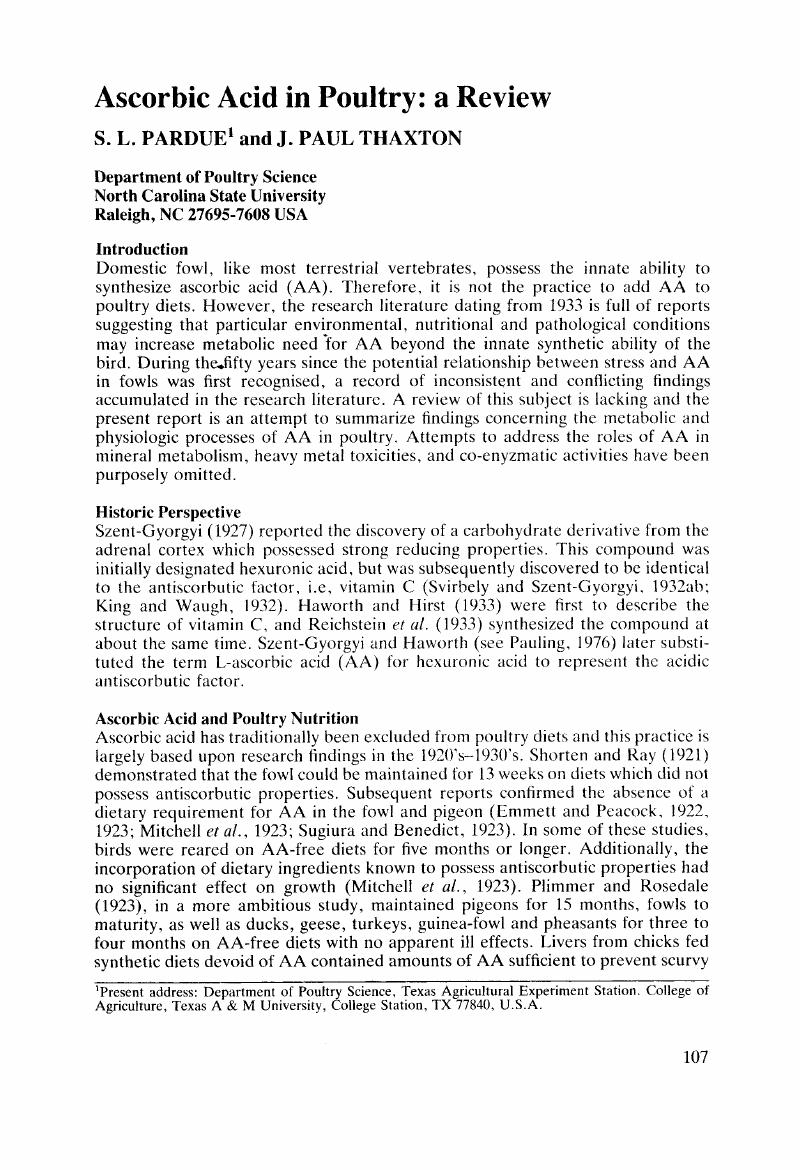Crossref Citations
This article has been cited by the following publications. This list is generated based on data provided by Crossref.
Novikova, A. N.
Mamedov, L. A.
Egorova, N. D.
Shekhter, A. B.
Nikolaev, A. V.
and
Zakharov, V. V.
1988.
Blood serum and granulation tissue ascorbic acid and hydroxyproline levels in rats with aseptic and infected wounds.
Bulletin of Experimental Biology and Medicine,
Vol. 106,
Issue. 3,
p.
1334.
Satterlee, D.G
Aguilera-Quintana, I
Munn, B.J
and
Krautmann, B.A
1989.
Vitamin C amelioration of the adrenal stress response in broiler chickens being prepared for slaughter.
Comparative Biochemistry and Physiology Part A: Physiology,
Vol. 94,
Issue. 4,
p.
569.
Njoku, P. C.
and
Nwazota, Adeline O. U.
1989.
Effect of dietary inclusion of ascorbic acid and palm oil on the performance of laying hens in a hot tropical environment.
British Poultry Science,
Vol. 30,
Issue. 4,
p.
831.
van NIEKERK, T.
GARBER, T.K.
DUNNINGTON, E.A.
GROSS, W.B.
and
SIEGEL, P.B.
1989.
Response of White Leghorn Chicks Fed Ascorbic Acid and Challenged with Escherichia coli or with Corticosterone.
Poultry Science,
Vol. 68,
Issue. 12,
p.
1631.
WILSON, H.R.
1989.
Research Note: Chick Mortality in Bobwhite Quail as Affected by Supplemental Ascorbic Acid.
Poultry Science,
Vol. 68,
Issue. 10,
p.
1418.
CHENG, THIM K.
COON, CRAIG N.
and
HAMRE, MELVIN L.
1990.
Effect of Environmental Stress on the Ascorbic Acid Requirement of Laying Hens.
Poultry Science,
Vol. 69,
Issue. 5,
p.
774.
Benabdeljelil, K.
Ryadi, A.
and
Jensen, L.S.
1990.
Effect of dietary ascorbic acid supplementation on the performance of brown-egg layers and egg quality.
Animal Feed Science and Technology,
Vol. 30,
Issue. 3-4,
p.
301.
DONOGHUE, D.J.
KRUEGER, W.F.
DONOGHUE, A.M.
BYRD, J.A.
ALI, D.H.
and
EL HALAWANI, M.E.
1990.
Magnesium-Aspartate-Hydrochloride Reduces Weight Loss in Heat-Stressed Laying Hens.
Poultry Science,
Vol. 69,
Issue. 11,
p.
1862.
BELL, D.E.
and
MARION, J.E.
1990.
Vitamin C in Laying Hen Diets.
Poultry Science,
Vol. 69,
Issue. 11,
p.
1900.
BALNAVE, D.
ZHANG, D.
and
MORENG, R.E.
1991.
Use of Ascorbic Acid to Prevent the Decline in Eggshell Quality Observed with Saline Drinking Water.
Poultry Science,
Vol. 70,
Issue. 4,
p.
848.
Monsi, A.
and
Onitchi, D.O.
1991.
Effects of ascorbic acid (vitamin C) supplementation on ejaculated semen characteristics of broiler breeder chickens under hot and humid tropical conditions.
Animal Feed Science and Technology,
Vol. 34,
Issue. 1-2,
p.
141.
FLETCHER, D.L.
and
CASON, J.A.
1991.
Influence of Ascorbic Acid on Broiler Shrink and Processing Yields.
Poultry Science,
Vol. 70,
Issue. 10,
p.
2191.
Takahashi, Kazuaki
Akiba, Yukio
and
Horiguchi, Masaaki
1992.
Effect of an antithyroid agent (propylthiouracil) and L-ascorbic acid on mixed-function oxidase and drug metabolism in hepatic microsomes of chickens.
Comparative Biochemistry and Physiology Part C: Comparative Pharmacology,
Vol. 102,
Issue. 1,
p.
73.
PEEBLES, E. DAVID
MILLER, E.H.
BRAKE, J.D.
and
SCHULTZ, C.D.
1992.
Effects of Ascorbic Acid on Plasma Thyroxine Concentrations and Eggshell Quality of Leghorn Chickens Treated with Dietary Thiouracil.
Poultry Science,
Vol. 71,
Issue. 3,
p.
553.
Donaldson, W.E
and
Christensen, V.L
1992.
Effects of injections of l-alanine, l-glucose and l-ascorbic acid in newly-hatched turkey poults on glucose metabolism.
Comparative Biochemistry and Physiology Part A: Physiology,
Vol. 101,
Issue. 4,
p.
849.
PARDUE, S.L.
BRAKE, J.
SEIB, P.A.
and
WANG, X.Y.
1993.
Relative Bioavailability of L-Ascorbyl-2-Polyphosphate in Broiler Chickens.
Poultry Science,
Vol. 72,
Issue. 7,
p.
1330.
ORBAN, J.I.
ROLAND, D.A.
CUMMINS, K.
and
LOVELL, R.T.
1993.
Influence of Large Doses of Ascorbic Acid on Performance, Plasma Calcium, Bone Characteristics, and Eggshell Quality in Broilers and Leghorn Hens.
Poultry Science,
Vol. 72,
Issue. 4,
p.
691.
Satterlee, Daniel G.
Bryan Jones, R.
and
Ryder, Francie H.
1993.
Effects of Vitamin C supplementation on the adrenocortical and tonic immobility fear reactions of Japanese quail genetically selected for high corticosterone response to stress.
Applied Animal Behaviour Science,
Vol. 35,
Issue. 4,
p.
347.
Takahashi, Kazuaki
Akiba, Yukio
and
Horiguchi, Masaaki
1993.
Sex-related differences of hepatic microsomal mixed function oxidase system and antibody production in broilers implanted with corticosterone and/or fed ascorbic acid.
Comparative Biochemistry and Physiology Part C: Comparative Pharmacology,
Vol. 105,
Issue. 2,
p.
159.
Silva, R.D.M.
Menten, J.F.M.
Cardoso, M.K.
and
Ghirardi, G.G.
1993.
Suplementação de vitamina C associada à densidade de criação no desempenho de frangos de corte.
Scientia Agricola,
Vol. 50,
Issue. 3,
p.
490.





